Victor Frankenstein’s Library
Frankenstein’s titular character, Victor Frankenstein, blurs the divide between life and death. The selected texts influence Victor’s dual personae: the natural philosopher, consumed with the creation of life, and the humanist, haunted by his ambition. The alchemical and galvanic texts inform Victor’s animation of the Creature, the others his subsequent ethical dilemmas. Ultimately, Victor’s Library encompasses Frankenstein’s conflict between alchemical interest and romantic sensibilities.
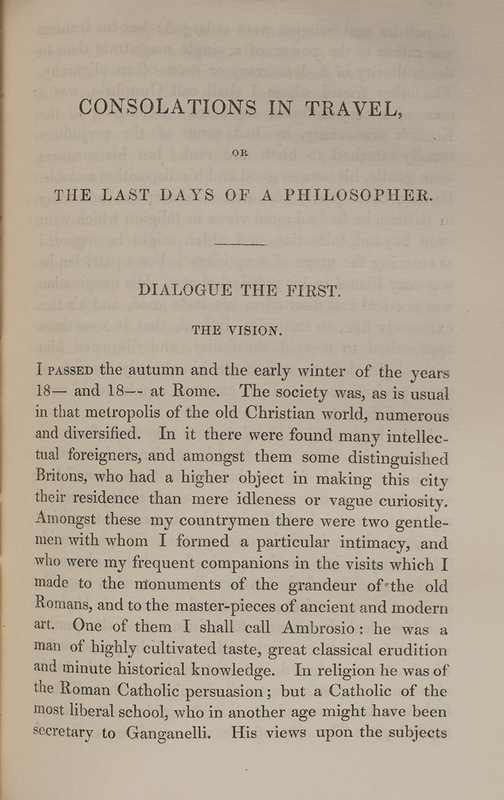
Humphry Davy, Consolations in Travel: or, The Last Days of a Philosopher, vol. 9 of The Collected Works of Sir Humphry Davy, Bart., ed. John Davy (London: Smith, Elder and co., 1840)
Consolations in Travel
Davy
Crucial to the understanding of Victor Frankenstein’s creative ambitions is a knowledge of his historical context, and the natural philosophers upon whose shoulders he stands. One such figure informing Frankenstein’s framework is Humphry Davy, a celebrated chemist and lecturer in early 19th-century England. Although Davy’s works span decades and myriad subjects, his final work is especially salient to the subject of Frankenstein’s philosophical formation—Consolations in Travel: or, The Last Days of a Philosopher. Davy wrote the text during a brief interlude between two bouts of a serious illness. In this liminal state between life and death, Davy muses on questions quite relevant to Frankenstein’s own ethical quandary. In a chapter entitled “The Proteus, or Immortality,” for example, the chemist travels through a soothing pastoral landscape to heal his physical and mental anguish. Here, he encounters a man labelled only the“Stranger,” who introduces Davy to the bizarre Proteus fish. The Proteus sustains itself through mechanisms that seem to unlock the mystery of immortality; and naturally, Davy reflects on the religious implications of such a discovery. He scorns the materialist view of the origins of life, disdaining the idea that immortality is contained only in a creature’s flesh, and instead praises divine love as the spark of life and eternal existence. Ultimately, with its exploration of metaphysical life, its rhetorical style, and its popular influence, Humphry Davy’s The Last Days of a Philosopher provides powerful resonances with Frankenstein and forms an integral part of the contextual library.
-Griffin Reed
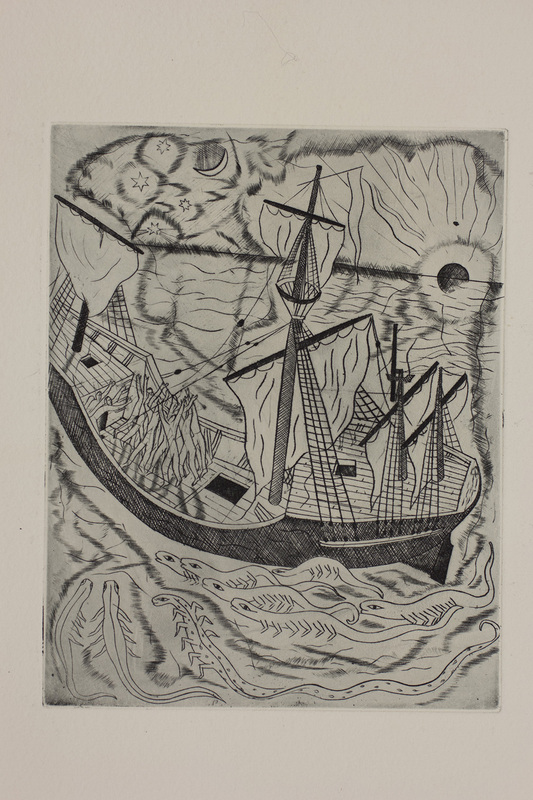
Samuel Taylor Coleridge, The Rime of the Ancient Mariner, illus. David Jones (New York: Chilmark Press, 1964)
The Rime of the Ancient Mariner
Coleridge
Coleridge’s The Rime of the Ancient Mariner makes numerous appearances throughout Mary Shelley’s Frankenstein. From her childhood, Shelley encountered Coleridge. Her father, William Godwin, was a close friend of Coleridge’s and hosted the poet in the family home. Speculation suggests that Mary Shelley heard Coleridge recite the poem at a young age. The influence of the text on Shelley need not be inferred, though, as references abound throughout the novel. Victor Frankenstein contemplates a portion of the poem immediately after seeing his creature awaken. In it, Victor considers the impending doom that follows from the Mariner’s decision to conquer nature and foreshadows the unspeakable acts in Frankenstein. The employment of Coleridge builds the character of Victor by offering a humanist side to the natural philosopher otherwise consumed with alchemists such as Agrippa. With the multi-faceted character of Victor, Shelley begins to develop the ambiguity of the story, where the center characters have layers initially unseen. Engravings of David Jones accompany the Coleridge poem. Although they are an addition over a century after Shelley’s death, the illustrations offer a visual depiction of the destruction that follows the Mariner’s fateful decision. The displayed image comes from the eighth of ten pages. The engraving depicts the Mariner entirely powerless to the forces of nature, with the accompanying poetry that Victor utters after the awakening of his monster. The combination of the text, its employment in the novel, and the illustration invite a consideration of nature and its constant ability to assert itself to man.
-Nate Rickard
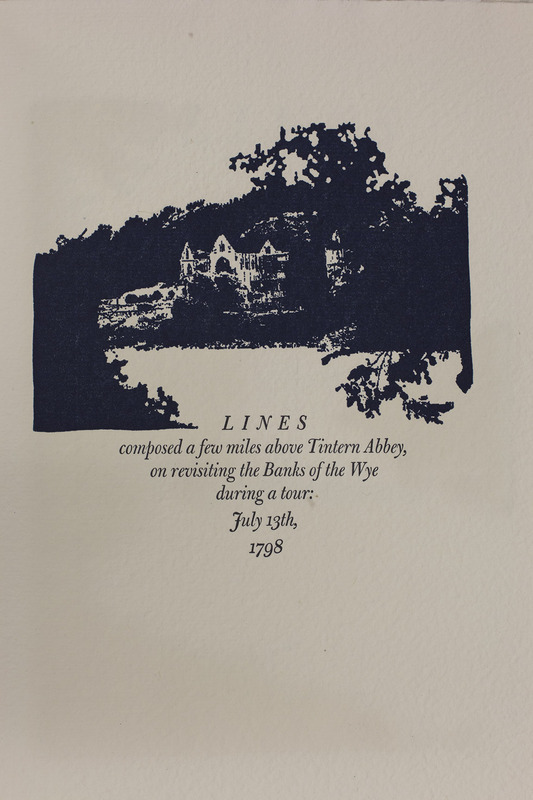
William Wordsworth, Lines Composed a Few Miles Above Tintern Abbey (Llandogo, Monmouthshire: Old Stile Press, 2002)
Tintern Abbey
Wordsworth
This is a 2002 edition of Tintern Abbey, containing images from the stretch of river that inspired Wordsworth’s poem. The book’s paper is handmade and was made with water from the river two miles upstream from Tintern Abbey, roughly where Wordsworth was when he found the inspiration for the poem.
Tintern Abbey was first published in Wordsworth and Coleridge’s foundational text Lyrical Ballads. Arguably the foundational text of Romantic Poetry, Coleridge and Wordsworth’s joint collection of poems includes such famous texts as Rime of the Ancient Mariner. The text was originally published in 1798, But Shelley did not read it until 1814, so it is likely that she read the second publishing. In this publishing, Wordsworth adds a preface to the text in which he claims that “all good poetry is the spontaneous overflow of powerful feelings.”
Shelley cites Tintern Abbey when describing Clerval and Victor’s relationship with nature and uses it to demonstrate their differing approaches to and appreciation of nature. Thus, one might argue that these characters agree at least with this sentiment about the purpose of poetry and the “overflow of powerful feelings” proposed in this work.
-Deborah Rookey
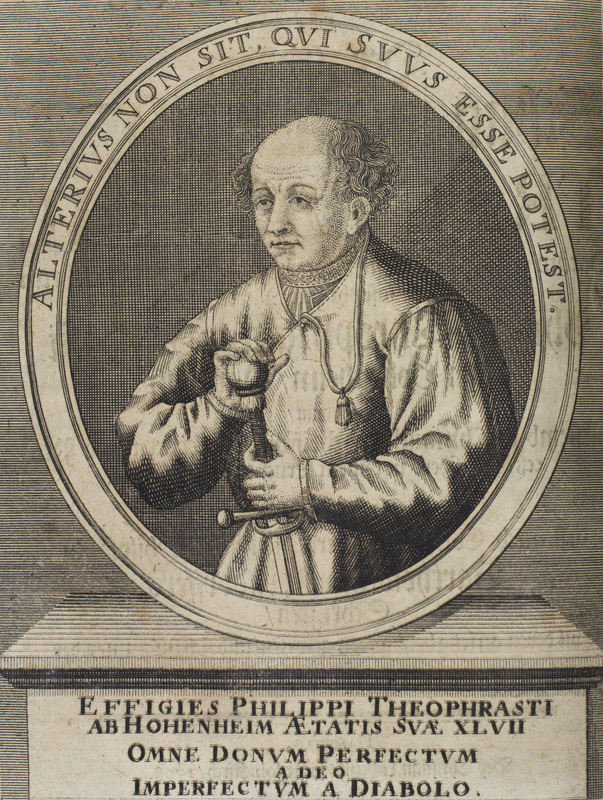
Paracelsus, et.al., Aurem vellus, oder, Guldin Schatz und Kunst-Kammer (Hamburg: bey Christian Liebzeit, 1708.
Paracelsus
This volume contains a collection of essays from various alchemists, including Bartholomäus Korndörffer (a traveling alchemist), Salomon Trismosin (a teacher of Paracelsus) and Paracelsus. Paracelsus’s essay title, translated from German, roughly reads “The Golden River of Theophrastus Paracelsus, Which is a Dialogue regarding Alchemy, of Theophrastus to Christophilus.” The left facing page of the essay features a portrait of Paracelsus and, having been published in 1708, could easily have been a text that found its way into the hands of many 18th-century authors, including Mary Shelley. Although he only lived for 47 years, Paracelsus pioneered many methods and practices of the German Renaissance (15th and 16th centuries), including alchemy, chemistry, astrology, and toxicology.
Paracelsus can be linked strongly to the philosopher’s stone, a mythical alchemical substance believed to have the power to turn base metals into gold or silver. This is alluded to in the Paracelsus in this collection, as the literal translation means “the one who desires much gold.” He believed in a fifth, hypothetical universal solvent called Alkahest, which he attempted to concoct himself using various minerals and potassium carbonate. In addition to his work with the alchemical, Paracelsus made great strides in medicine, using chemistry to instruct medical students and using his experience as a military surgeon to advocate for medicinal cleanliness. Although he published multiple works it is only because of Karl Widemann, a 16th-century German author who copied and collected more than 30 years of Paracelsus’s work, that these texts are now available.
-Victoria Rabuse
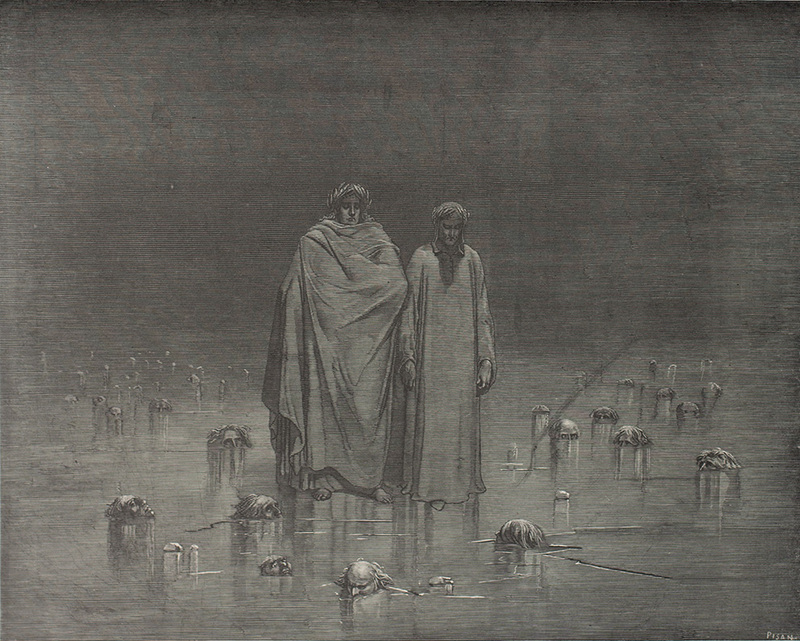
Dante Alighieri, L’enfer, illus. Gustave Doré, trans. Pier-Angelo Fiorentino (Paris: L. Hachette et cie., 1865)
Inferno
Dante
Dante’s Inferno was composed between 1308 and 1321 and follows the poet through the circles of Hell. The poem created the image of Hell that the Western world imagines, and this tradition of representation can be found in art and literature throughout Europe. The edition shown was published in 1865 by Gustave Doré and includes his famous illustrations, part of his series illustrating classical literature. This image, titled the Cocytus illustration, depicts Dante and Virgil standing atop the frozen lake containing souls condemned for treachery. Doré created over 60 illustrations for the Inferno, before illustrating the rest of Dante’s Divine Comedy. The events within Shelley’s Frankenstein, which often resemble Doré’s illustrations, draw influence from Dante’s poem. Mary Shelley read the Inferno three times, first in 1818 and again in 1819 and 1820, and the epic is directly referenced within her novel three times. It is the character of Victor Frankenstein who continually references Dante, first declaring that his creation is far uglier than anything Dante dreamed up. Victor comes to view his dealings with his creation like the iron cowl worn by hypocrites. The final reference draws parallels between Victor and Ulysses, who resides in Hell due to the pursuit of meaningless personal glory. The imagery Victor uses when bemoaning how his world has turned into a hellish landscape comes from a tradition originating with Dante’s image of Hell. The final events of the novel take place in the Arctic, in a landscape resembling the final, icy circle of Hell.
-Rachel Brace
Opera
Agrippa
Opera Omnia is the first of two volumes, which together make up all of Heinrich Cornelius Agrippa von Nettesheim’s written works. Although the exact year is unknown, the British Library dates this piece to 1630. Several notable texts within the book are De Occulta Philosophia Libri Tres, Devination Varia, and the fabled fourth book of De Occulta. It should be noted, however, that this fourth book is widely considered to not actually have been written by Agrippa. The three books on occult philosophy draw heavily on ancient Kabbalistic traditions, which Agrippa learned, in part, from Christian interpretations of the practice. In the first of these three books, Agrippa focuses on the natural occurrences of magic, such as how the stars of the cosmos correspond and relate to life on earth, and the three types of elements. The second book explores the power of astrology, and describes various astrological attributes and visions. These concepts correspond to the divine power of the planets, and how they affect earthly beings; that is, depending on the stars and astrological bodies assigned to you, you could have a specific type or amount of power. Finally, the third book explores a decidedly religious form of magic, which combines the powers of the ethereal and the earthly. Agrippa shows that this magic is only able to be practiced by the most divine and pious, and finds a religious basis for it. However, this supposed spark of magic is absent in most of humankind.
-Kate Taub

![Henrici Cornelii Agrippae ab Nettesheym ... Opera : in duos tomos concinne digesta, & nunc denuò, sublatis omnibus mendis, in [philomasōn] gratiam accuratissimè recusa : quibus post omnium editiones de novo accessit Ars notoria, ut satis indicat catalogus post praefationem positus Henrici Cornelii Agrippae ab Nettesheym ... Opera : in duos tomos concinne digesta, & nunc denuò, sublatis omnibus mendis, in [philomasōn] gratiam accuratissimè recusa : quibus post omnium editiones de novo accessit Ars notoria, ut satis indicat catalogus post praefationem positus](http://omeka.wustl.edu/omeka/files/fullsize/972fca7c1be24d2bbf4f8017da616843.jpg)